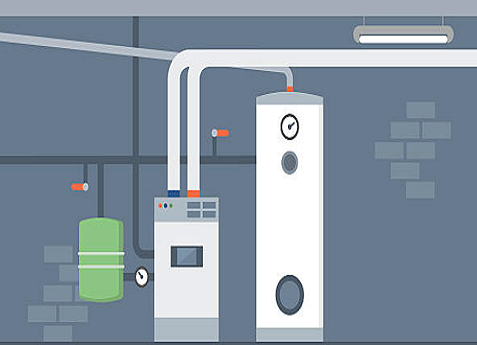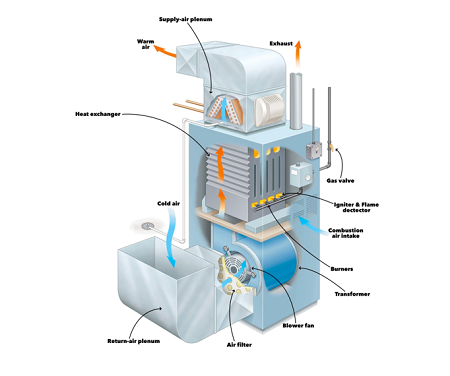A Guide to Furnace Systems
Your furnace system provides an essential service to your home, but most people don’t know how they work or the components that make up the furnace system. Understanding how this system works can help you identify problems early so you can have your furnace repaired by an HVAC technician. Let’s discuss how your furnace works and what the parts of your system do.
How Your Furnace System Works
Simply put, your furnace heats your home by pulling in cool air inside of your home and heating it. The furnace system then redistributes the warm air throughout your home through ducts and vents. Furnaces can be fueled by natural gas, oil, electricity, wood, propane, or coal. Most furnace systems use electricity and natural gas or oil, but each works a little differently.
Natural Gas Furnace
A natural gas furnace is a forced air heating system in which gas is mixed inside the burner and ignited in the combustion chamber. A blower pulls cool air from your home into the furnace, where it is heated by passing over a heat exchanger connected to the combustion chamber. The furnace system then circulates the warm air back to your home’s rooms through ductwork. A flue through the roof or side wall vent releases the exhaust gasses from the burner outside your home.
Oil Furnace
An oil-fired furnace system works pretty similarly to a natural gas furnace. But instead of natural gas, the oil used is turned into a mist and burned. The air in the exchanger absorbs the heat, and a blower sends the warm air throughout your home via ductwork. Emissions from the burner and furnace system are then vented outside.
Electric Furnace
An electric furnace system is also a forced air heating system which uses a blower unit to blow air directly over electrically heated coils. Through ductwork, the warm air is redistributed to the rooms in your home. These furnace systems can be used with heat pumps or central air conditioners.
Parts of Your Furnace System
Understanding what each part of your furnace system does is a great way to stay ahead of furnace repairs and installations. Let’s dive into what each part does to heat your home.
Return Register
Air is recycled through your home, and the return register is part of the first step of the heating process. Return registers are typically located in a hallway or in a ceiling, anywhere cold air may be. The return register pulls cold air from inside your home and sends it to your furnace system to be heated.
Return Duct
Return ducts direct the cool air that is pulled in by the return register. The return ductwork sends this air directly to the furnace system to be heated.
Air Filter
HVAC air filters are a small part of the furnace system but are essential for the health and safety of everyone in your home. The return register brings the air into the furnace, and the duct passes through the air filter. HVAC air filters trap any indoor air contaminants, pollution, or allergens, stopping them from being continuously redistributed throughout your home.
Blower
The blower is a large component with a fan in your furnace system that blows air through your HVAC system and into the supply ductwork. The return register and duct pull air into the system, but the cool air has nowhere to go without a blower.
Blower Motor
The blower motor is pretty self-explanatory, it powers the blower and spins the fan. This component provides power to the blower, allowing it to push air through the HVAC system.
Blower Chamber
The blower chamber is where the blower and blower motor are located. This box helps stabilize the blower and ensures everything in the system is working properly.
Burners
The burners are where the fire comes from in your furnace system. If you have a natural gas furnace, the burners pull natural gas from a gas line to make the fire.
Flame Sensor
The flame sensor is a small rod that is a vital part of your furnace system. It detects when a fire is lit in the burner chamber and senses if no heat is being generated from the system. This is where its importance comes in. The flame sensor will shut the entire system down to avoid any gas leaks or other issues, keeping you and your family safe.
Pilot Light or Electronic Ignition
Pilot lights and electronic ignitions are very similar but have different safety levels. Older furnaces will most likely have a pilot light, whereas newer furnace systems will have an electronic ignition. Pilot lights consistently run even when the furnace is off, but this can cause issues. A pilot light always uses gas, which can add up over time, and a draft can easily blow it out. Relighting a pilot light can be annoying and potentially dangerous, that’s why newer furnaces use an electronic ignition.
An electronic ignition is the updated version of a pilot light. Your furnace system sends a signal to the electronic ignition when your home is ready for heat, which will send a spark to the burner.
Burner Cover
The burner cover, typically a small, rectangular piece of metal, covers the burners, flame sensor, blower chamber, and pilot light or electronic ignition. It is a safety measure that keeps the flames inside the furnace system.
Combustion Chamber
The combustion chamber holds the entire fire system in place, specifically the burners, flame sensor, flames, and pilot light or electronic ignition. This chamber is safely separated from the blower chamber.
Heat Exchanger
The heat exchanger provides safe and warm air to your home. Hot combustion gasses are sent inside the heat exchanger, warming the walls. The heat from the walls transfers to the filtered air inside the system. After the heating process is complete, the remaining combustion gasses are sent into the flue or side wall vent to be released outside of your home, keeping harmful gasses out.
Supply Plenum
The supply plenum receives the newly warmed air from the heat exchanger and prepares to redistribute it throughout your home.
Damper
The heated air goes to the damper, which regulates the amount of air released into your home. The damper sends air to different places in your home, depending on which rooms need it. You can control this by changing the settings on your thermostat.
Supply Duct
Once the damper has sorted out the right amount of air, it is sent to the supply duct, which supplies your home with the newly heated air.
Supply Register
The last step in your furnace system’s heating process is to pass the heated air through the supply registers in your home. Supply registers are typically located around baseboards to distribute treated air into your home.
Keep Up With Your Furnace Maintenance
Routine furnace maintenance from an HVAC technician is important for keeping your furnace system running properly. By hiring a professional HVAC company to perform furnace repairs or installations, you can keep your family safe from fire, gas leaks, and any other issues with your furnace system.

